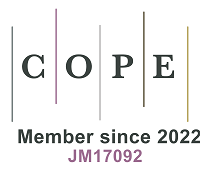REFERENCES
2. Needham LL, Calafat AM, Barr DB. Uses and issues of biomonitoring. Int J Hyg Environ Health 2007;210:229-38.
3. Henríquez-Hernández LA, Ortiz-Andrelluchi A, Álvarez-Pérez J, et al. Human biomonitoring of persistent organic pollutants in elderly people from the Canary Islands (Spain): a temporal trend analysis from the PREDIMED and PREDIMED-Plus cohorts. Sci Total Environ 2021;758:143637.
4. Albertini R, Bird M, Doerrer N, et al. The use of biomonitoring data in exposure and human health risk assessments. Environ Health Perspect 2006;114:1755-62.
5. Zhou Q, Zhang J, Fu J, Shi J, Jiang G. Biomonitoring: an appealing tool for assessment of metal pollution in the aquatic ecosystem. Anal Chim Acta 2008;606:135-50.
6. Wang Y, Hsu J, Hsu Y, Liao P. Identification of potential urinary exposure markers for the toxicant diisononyl phthalate in rubber worker urine specimens by high-resolution mass spectrometry-based metabolomics. URINE 2019;1:8-16.
7. Klotz K, Weiß T, Zobel M, et al. Validity of different biomonitoring parameters in human urine for the assessment of occupational exposure to naphthalene. Arch Toxicol 2019;93:2185-95.
8. Crinnion WJ. The CDC fourth national report on human exposure to environmental chemicals: what it tells us about our toxic burden and how it assists environmental medicine physicians. Altern Med Rev 2010;15:101-9.
9. USCDC. Fourth national report on human exposure to environmental chemicals. Updated tables, March 2021 : volume three: analysis of pooled serum samples for select chemicals, NHANES 2005-2016. Available from: https://stacks.cdc.gov/view/cdc/105344. [Last accessed on 15 Aug 2024].
10. Hoppin JA, Brock JW, Davis BJ, Baird DD. Reproducibility of urinary phthalate metabolites in first morning urine samples. Environ Health Perspect 2002;110:515-8.
11. Slupsky CM, Rankin KN, Wagner J, et al. Investigations of the effects of gender, diurnal variation, and age in human urinary metabolomic profiles. Anal Chem 2007;79:6995-7004.
12. Saude EJ, Adamko D, Rowe BH, Marrie T, Sykes BD. Variation of metabolites in normal human urine. Metabolomics 2007;3:439-51.
13. Giskeødegård GF, Davies SK, Revell VL, Keun H, Skene DJ. Diurnal rhythms in the human urine metabolome during sleep and total sleep deprivation. Sci Rep 2015;5:14843.
14. Caplan YH, Goldberger BA. Alternative specimens for workplace drug testing. J Anal Toxicol 2001;25:396-9.
15. Jang WJ, Choi JY, Park B, et al. Hair metabolomics in animal studies and clinical settings. Molecules 2019;24:2195.
16. Alves A, Kucharska A, Erratico C, et al. Human biomonitoring of emerging pollutants through non-invasive matrices: state of the art and future potential. Anal Bioanal Chem 2014;406:4063-88.
17. Hardy EM, Dereumeaux C, Guldner L, et al. Hair versus urine for the biomonitoring of pesticide exposure: Results from a pilot cohort study on pregnant women. Environ Int 2021;152:106481.
18. Hsu JY, Ho HH, Liao PC. The potential use of diisononyl phthalate metabolites hair as biomarkers to assess long-term exposure demonstrated by a rat model. Chemosphere 2015;118:219-28.
19. Hsu JF, Chang WC, Ho WY, Liao PC. Exploration of long-term exposure markers for phthalate esters in human hair using liquid chromatography-tandem mass spectrometry. Anal Chim Acta 2022;1200:339610.
20. Shih CL, Wu HY, Liao PM, et al. Profiling and comparison of toxicant metabolites in hair and urine using a mass spectrometry-based metabolomic data processing method. Anal Chim Acta 2019;1052:84-95.
21. Delplancke TDJ, de Seymour JV, Tong C, et al. Analysis of sequential hair segments reflects changes in the metabolome across the trimesters of pregnancy. Sci Rep 2018;8:36.
23. Iglesias-González A, Schweitzer M, Palazzi P, et al. Investigating children’s chemical exposome - Description and possible determinants of exposure in the region of Luxembourg based on hair analysis. Environ Int 2022;165:107342.
24. Chang CW, Hsu JY, Su YH, Chen YC, Hsiao PZ, Liao PC. Monitoring long-term chemical exposome by characterizing the hair metabolome using a high-resolution mass spectrometry-based suspect screening approach. Chemosphere 2023;332:138864.
25. Ruiz-Castell M, Le Coroller G, Pexaras A, et al. Characterizing the adult exposome in men and women from the general population: Results from the EHES-LUX study. Environ Int 2023;173:107780.
26. Gilles L, Govarts E, Rodriguez Martin L, et al. Harmonization of human biomonitoring studies in Europe: characteristics of the HBM4EU-aligned studies participants. Int J Environ Res Public Health 2022;19:6787.
27. Polledri E, Mercadante R, Consonni D, Fustinoni S. Cumulative pesticides exposure of children and their parents living near vineyards by hair analysis. Int J Environ Res Public Health 2021;18:3723.
28. Bucher ML, Anderson FL, Lai Y, Dicent J, Miller GW, Zota AR. Exposomics as a tool to investigate differences in health and disease by sex and gender. Exposome 2023;3:osad003.
29. Ding E, Wang Y, Liu J, Tang S, Shi X. A review on the application of the exposome paradigm to unveil the environmental determinants of age-related diseases. Hum Genomics 2022;16:54.
30. Costanzo M, Caterino M, Sotgiu G, Ruoppolo M, Franconi F, Campesi I. Sex differences in the human metabolome. Biol Sex Differ 2022;13:30.
31. Muthubharathi BC, Gowripriya T, Balamurugan K. Metabolomics: small molecules that matter more. Mol Omics 2021;17:210-29.
32. Chang WC, Wang PH, Chang CW, Chen YC, Liao PC. Extraction strategies for tackling complete hair metabolome using LC-HRMS-based analysis. Talanta 2021;223:121708.
33. Tsugawa H, Cajka T, Kind T, et al. MS-DIAL: data-independent MS/MS deconvolution for comprehensive metabolome analysis. Nat Methods 2015;12:523-6.
34. Kind T, Tsugawa H, Cajka T, et al. Identification of small molecules using accurate mass MS/MS search. Mass Spectrom Rev 2018;37:513-32.
35. Tsugawa H, Kind T, Nakabayashi R, et al. Hydrogen rearrangement rules: computational MS/MS fragmentation and structure elucidation using MS-FINDER software. Anal Chem 2016;88:7946-58.
36. Schymanski EL, Jeon J, Gulde R, et al. Identifying small molecules via high resolution mass spectrometry: communicating confidence. Environ Sci Technol 2014;48:2097-8.
37. Djoumbou Feunang Y, Eisner R, Knox C, et al. ClassyFire: automated chemical classification with a comprehensive, computable taxonomy. J Cheminform 2016;8:61.
38. Pang Z, Chong J, Zhou G, et al. MetaboAnalyst 5.0: narrowing the gap between raw spectra and functional insights. Nucleic Acids Res 2021;49:W388-96.
39. Wishart DS, Guo A, Oler E, et al. HMDB 5.0: the human metabolome database for 2022. Nucleic Acids Res 2022;50:D622-31.
40. Thomas MH, Pelleieux S, Vitale N, Olivier JL. Dietary arachidonic acid as a risk factor for age-associated neurodegenerative diseases: potential mechanisms. Biochimie 2016;130:168-77.
41. Forner F, Kumar C, Luber CA, Fromme T, Klingenspor M, Mann M. Proteome differences between brown and white fat mitochondria reveal specialized metabolic functions. Cell Metab 2009;10:324-35.
42. Corona-Meraz FI, Vázquez-Del Mercado M, Ortega FJ, Ruiz-Quezada SL, Guzmán-Ornelas MO, Navarro-Hernández RE. Ageing influences the relationship of circulating miR-33a and miR- 33b levels with insulin resistance and adiposity. Diab Vasc Dis Res 2019;16:244-53.
43. Sibbons CM, Brenna JT, Lawrence P, et al. Effect of sex hormones on n-3 polyunsaturated fatty acid biosynthesis in HepG2 cells and in human primary hepatocytes. Prostaglandins Leukot Essent Fatty Acids 2014;90:47-54.
44. Yang L, Zhang Y, Wang S, Zhang W, Shi R. Decreased liver peroxisomal β-oxidation accompanied by changes in brain fatty acid composition in aged rats. Neurol Sci 2014;35:289-93.
45. Muilwijk M, Callender N, Goorden S, Vaz FM, van Valkengoed IGM. Sex differences in the association of sphingolipids with age in Dutch and South-Asian Surinamese living in Amsterdam, the Netherlands. Biol Sex Differ 2021;12:13.
46. Hrelia S, Bordoni A, Celadon M, Turchetto E, Biagi PL, Rossi CA. Age-related changes in linoleate and alpha-linolenate desaturation by rat liver microsomes. Biochem Biophys Res Commun 1989;163:348-55.
47. Burdge GC, Calder PC. Dietary alpha-linolenic acid and health-related outcomes: a metabolic perspective. Nutr Res Rev 2006;19:26-52.
48. Vignoli A, Tenori L, Luchinat C, Saccenti E. Age and sex effects on plasma metabolite association networks in healthy subjects. J Proteome Res 2018;17:97-107.
49. Yarian CS, Toroser D, Sohal RS. Aconitase is the main functional target of aging in the citric acid cycle of kidney mitochondria from mice. Mech Ageing Dev 2006;127:79-84.
50. Snell K, Walker DG. Age-related changes in gluconeogenesis and the metabolism of alanine in the perfused liver of neonatal rats. Biochem Soc Trans 1975;3:128-9.
51. Agostini A, Yuchun D, Li B, Kendall DA, Pardon MC. Sex-specific hippocampal metabolic signatures at the onset of systemic inflammation with lipopolysaccharide in the APPswe/PS1dE9 mouse model of Alzheimer's disease. Brain Behav Immun 2020;83:87-111.
52. Xie K, Qin Q, Long Z, et al. High-throughput metabolomics for discovering potential biomarkers and identifying metabolic mechanisms in aging and Alzheimer’s disease. Front Cell Dev Biol 2021;9:602887.
53. van der Goot AT, Nollen EA. Tryptophan metabolism: entering the field of aging and age-related pathologies. Trends Mol Med 2013;19:336-44.
54. Songtachalert T, Roomruangwong C, Carvalho AF, Bourin M, Maes M. Anxiety disorders: sex differences in serotonin and tryptophan metabolism. Curr Top Med Chem 2018;18:1704-15.
55. Durani LW, Hamezah HS, Ibrahim NF, et al. Age-related changes in the metabolic profiles of rat hippocampus, medial prefrontal cortex and striatum. Biochem Biophys Res Commun 2017;493:1356-63.
56. Stadtman ER, Van Remmen H, Richardson A, Wehr NB, Levine RL. Methionine oxidation and aging. Biochim Biophys Acta 2005;1703:135-40.
57. Luo HH, Feng XF, Yang XL, Hou RQ, Fang ZZ. Interactive effects of asparagine and aspartate homeostasis with sex and age for the risk of type 2 diabetes risk. Biol Sex Differ 2020;11:58.
58. Goyary D, Sharma R. Late onset of dietary restriction reverses age-related decline of malate-aspartate shuttle enzymes in the liver and kidney of mice. Biogerontology 2008;9:11-8.
59. Saransaari P, Oja SS. Characterization of sodium-independent beta-alanine binding to cerebral cortical membranes from 7-day-old and adult mice. Int J Dev Neurosci 1994;12:491-7.
60. Taskiran D, Sagduyu A, Yüceyar N, Kutay FZ, Pögün S. Increased cerebrospinal fluid and serum nitrite and nitrate levels in amyotrophic lateral sclerosis. Int J Neurosci 2000;101:65-72.
61. Zhu H, Wang N, Yao L, et al. Moderate UV exposure enhances learning and memory by promoting a novel glutamate biosynthetic pathway in the brain. Cell 2018;173:1716-27.e17.
62. Wehner G, Schweikert HU. Estrone sulfate source of estrone and estradiol formation in isolated human hair roots: identification of a pathway linked to hair growth phase and subject to site-, gender-, and age-related modulations. J Clin Endocrinol Metab 2014;99:1393-9.
63. Stanhewicz AE, Wenner MM, Stachenfeld NS. Sex differences in endothelial function important to vascular health and overall cardiovascular disease risk across the lifespan. Am J Physiol Heart Circ Physiol 2018;315:H1569-88.
64. Murray A, Tharmalingam S, Nguyen P, Tai TC. Untargeted metabolomics reveals sex-specific differences in lipid metabolism of adult rats exposed to dexamethasone in utero. Sci Rep 2021;11:20342.
65. Zhang PP, Ma KX, Ke XF, et al. Development and validation of a five-RNA-based signature and identification of candidate drugs for neuroblastoma. Front Genet 2021;12:685646.
66. Li H, Rong Z, Wang H, et al. Proteomic analysis revealed common, unique and systemic signatures in gender-dependent hepatocarcinogenesis. Biol Sex Differ 2020;11:46.
67. Auley MT, Mooney KM, Salcedo-Sora JE. Computational modelling folate metabolism and DNA methylation: implications for understanding health and ageing. Brief Bioinform 2018;19:303-17.
68. Liu X, Zhang M, Liu X, et al. Investigation of plasma metabolic and lipidomic characteristics of a chinese cohort and a pilot study of renal cell carcinoma biomarker. Front Oncol 2020;10:1507.
69. Fukuwatari T, Wada H, Shibata K. Age-related alterations of B-group vitamin contents in urine, blood and liver from rats. J Nutr Sci Vitaminol 2008;54:357-62.
70. Caterino M, Ruoppolo M, Villani GRD, et al. Influence of sex on urinary organic acids: a cross-sectional study in children. Int J Mol Sci 2020;21:582.
71. Plubell DL, Wilmarth PA, Zhao Y, et al. Extended multiplexing of tandem mass tags (TMT) labeling reveals age and high fat diet specific proteome changes in mouse epididymal adipose tissue. Mol Cell Proteomics 2017;16:873-90.
72. Leskanicova A, Chovancova O, Babincak M, et al. Sexual dimorphism in energy metabolism of wistar rats using data analysis. Molecules 2020;25:2353.
73. Pronk JT, van der Linden-Beuman A, Verduyn C, Scheffers WA, van Dijken JP. Propionate metabolism in Saccharomyces cerevisiae: implications for the metabolon hypothesis. Microbiology 1994;140:717-22.
74. Eisenbeiss L, Binz TM, Baumgartner MR, Kraemer T, Steuer AE. Cheating on forensic hair testing? Detection of potential biomarkers for cosmetically altered hair samples using untargeted hair metabolomics. Analyst 2020;145:6586-99.







